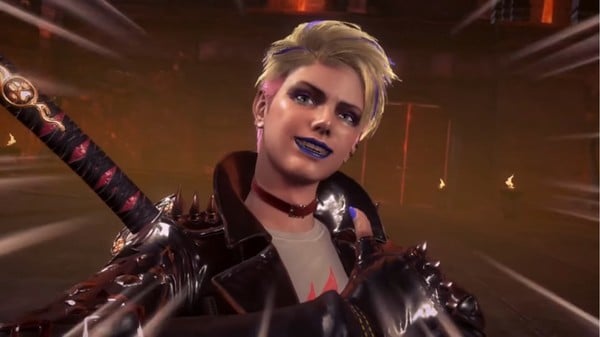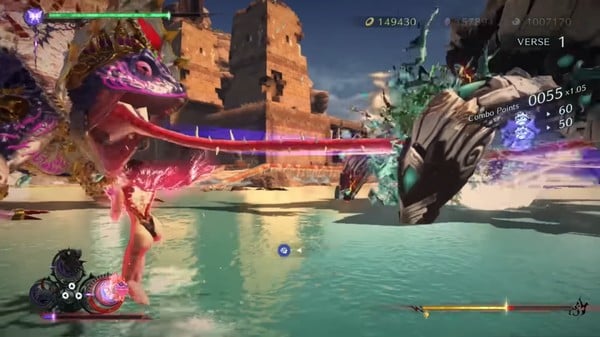Game Review
by Richard Eisenbeis,Bayonetta 3
Nintendo Switch
| Description: |  |
||
Across the multiverse, worlds are being destroyed by a being known as “Singularity” and his army of man-made monsters. The fate of all remaining universes rests on the shoulders of young multiversal soldier Viola and her quest to find the one version of legendary Umbra Witch Bayonetta capable of gathering the five Chaos Gears and taking the fight to Singularity on his home world. |
|||
| Review: | |||
 The basic gameplay loop remains largely constant across the game's 14 chapters. You play as Bayonetta, exploring a parallel world on the verge of collapse and encountering different versions of herself and her friends. In each world, you move between open areas connected by linear corridors filled with baddies. Each open space has several optional objectives: hidden chests and animals to find, challenge rooms to conquer, or jumping puzzles to overcome. You face off against minibosses before fighting the final boss of the world—which inevitably throws the normal gameplay mechanics out the window and replaces them with something like a bullet hell shooter, rhythm game, or the aforementioned game of Rock, Paper, Scissors.  Bayonetta 3 presents the best combat of the series so far. While you're now only able to equip one weapon at a time (as opposed to separate ones on your hands and feet), the variety of weapons and expanded move sets quickly make up for it—especially the creative ways Bayonetta merges with her weapons to end combos. Better still, Bayonetta 3 allows the titular heroine to summon any of her giant demons freely (as long as space allows) and control them directly. This completely changes combat and allows for all kinds of new combos. (And it doesn't hurt that you feel like a badass each time you summon a giant lady to stomp your enemies.) Unfortunately, it's outside of the combat that the game suffers. When it comes to jumping puzzles or certain challenge rooms, it feels like you're fighting the game's controls more than anything else. And while the sudden changes in gameplay during each world's climax are supposed to keep things exciting, they often derail the pace of the game—slamming the breaks on the non-stop action while you figure out a whole new system with only an unintuitive controller map as a guide for what you're supposed to do.  After every few chapters as Bayonetta, you'll get to play as either Viola or Jeanne. Viola's chapters are largely the same as Bayonetta's (though they inexplicably don't share their HP and MP bars, so you'll have to level them up separately). However, the big difference comes in how Viola plays. While she has only one set of weapons (her katana and exploding darts), she can summon Cheshire by throwing her sword, a demon who moves independently of Viola. This means that, unlike Bayonetta, who cannot do anything but dance in place when summoning, Viola can continue fighting with fists and feet even if her sword is otherwise occupied. This opens up more than a few creative combos between the pair. The other significant change in her gameplay is one of those things that's great in theory but terrible in execution: Viola activates her time-stopping powers (“Witch Time”) not by dodging but rather by blocking. The issue here is that when dodging as Bayonetta, even if you fail to activate Witch Time, you're still safe from damage and may even be able to avoid another hit in the same combo to activate it. In other words, there's no downside to mashing the dodge button when in danger. When blocking as Viola, however, there is a windup (i.e., the time between the button press and the time when damage negation starts) which means you not only have to start blocking earlier than you'd think but if you release the block to try and parry the next hit in a combo to activate Witch Time, you'll likely be stuck in the windup/winddown animation when the next attack comes. This dramatically alters the flow of combat as you're stuck in place, blocking until the enemies are done attacking you if you miss the window to activate Witch Time on the first hit—and makes what would be trivial groups of enemies for Bayonetta a deadly challenge for Viola. On the other hand, Jeanne's chapters are a 2D Metroid knock-off—and that's putting it kindly. Rather than running and gunning, these levels are stealth-based—even though a giant countdown timer encourages the opposite of careful, deliberate stealth action. Moreover, while a 2D Bayonetta game could be fun, Jeanne is locked out of the vast majority of her powers, making combat stilted and unenjoyable, especially in boss battles. Like so many things in the game, it is an exciting idea brought down by sub-par execution.  The writing is likewise polarizing. On the one hand, we have Viola. Eager to prove herself and full of teenage bluster, she is an excellent foil for someone like Bayonetta and steals every scene she's in. Her character manages to walk a fine line: while she could easily be nothing more than an annoying blowhard in the hands of a lesser writer, she instead comes off as a teen desperate to impress her hero. And while more than competent in a fight, Viola doesn't quite have the over-the-top stylishness that Bayonetta oozes—no matter how much she tries to emulate it. It all comes together to make her the right mix of badass and adorkable. She is, hands down, the best part of this game. On the other hand, we have the actual story. Don't get me wrong, while Bayonetta's plot has never been a literary masterpiece, it has always been competently told with excellent characters that tie everything together. However, it is also here that Bayonetta 3 stumbles. The parallel world-spanning adventure is a solid concept, but how it is handled is utterly predictable. The same plot beats repeat again and again in each world, and the game's key revelations (like both Viola and Singularity's identities) are obvious from the start. But the real problem is the game's final chapter, which manages to undercut Bayonetta 3's story and everything that came before. The following section contains major spoilers for the final chapter of Bayonetta 3  Simply put, in the final battle, Bayonetta is joined by the spirits of the Bayonettas from Bayonetta and Bayonetta 2. The implications of this range from nonsensical to staggering. On the one hand, this needlessly retcons the previous games into their separate parallel worlds—despite Bayonetta 2 being a sequel deeply interconnected with the first game. On the other, it means that the Bayonetta, Jeanne, and Luka we have spent Bayonetta 3 with are different people from those in the first two games. Because of this, their fates and struggles matter much less than they would normally—especially with the out-of-left-field love story and werewolf transformation bits that are completely out of character for the heroes we know and love. However, the worst thing to come out of this situation is the fact that the universes of Bayonetta and Bayonetta 2 were wiped out of existence long before the events of this game. This means that not only were all the characters you care about killed off-screen, but nothing you did in the other games mattered. You helped the two Bayonettas save their worlds, only to have some asshole from another dimension show up a few years later and kill everyone. It's horribly nihilistic and completely demoralizing. This game throws the previous games under the bus to have a climactic battle with three Bayonetta fighting in unison... you know, because it's called Bayonetta 3. It's a mess. If there is one place where the game is all highs and no lows, it's the soundtrack. From timeless classics to Viola's rocking battle theme, there's not a single song that doesn't work (and I'm not ashamed to admit I've had “Gh()st” on repeat while writing this review). As for the visuals, they are fine. The game looks about the same as the previous game's Switch port (which I played again right before this one) and is about what I would expect, given the Switch's hardware limitations. I didn't encounter any frame rate issues or noticeable graphical artifacts while playing the game in the Switch's docked mode. It's not the prettiest of games out there, but it's smooth and responsive, which is essential for an action-heavy game like this.  I have a serious love-hate relationship with Bayonetta 3. Even now, I want to re-experience my time with Viola, but the issues with her blocking mechanic make me not want to play as her. I want to relive Bayonetta's over-the-top craziness, but I don't want to go through the story again. I want to kick ass in giant kaiju battles, but the thought of wading through those half-assed mini-games is deeply unappealing. So, while I've replayed both previous Bayonetta games over the years, I highly doubt I'll ever do the same with this one. It's a shame because when Bayonetta 3 is great, it is sublime. It's just that it's torturous when it's not. Bayonetta 3 was released for the Nintendo Switch on October 28, 2022. Richard is an anime and video game journalist with over a decade of experience living and working in Japan. For more of his writings, check out his Twitter and blog. |
| Grade: | |||
|
Overall : C+
Graphics : C+
Sound/Music : B+
Gameplay : C+
Presentation : C
+ Viola and Cheshire are amazing characters. Great music. When the gameplay works, it surpasses even the best that the previous games had to offer. |
|||
| discuss this in the forum (17 posts) | | |||